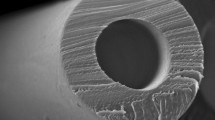Conclusions
It is possible to prepare a hollow gas-separating fibre from polyvinyltrimethylsilane.
The pore structure of the fibre and the associated gas-permeability are determined by the spinning method.
Wet spinning, depending on the solvent—precipitant system used, leads to fibres with various thicknesses of the porous and diffusion layers.
Similar content being viewed by others
Literature cited
V. F. Gustov et al., Summaries of Reports of the All-Union Conference on Membrane Methods of Separating Mixtures [in Russian], Moscow (1973), p. 175.
Yu. A. Kostrov et al., Khim. Volokna, No. 6, 50 (1978).
V. G. Andreev et al., Khim. Volokna, No. 3, 53 (1982).
Inventor's Certificate 825699 (1981) (USSR).
Additional information
Translated from Khimicheskie Volokna, No. 1, pp. 40–42, January–February, 1983.
Rights and permissions
About this article
Cite this article
Kostrov, Y.A., Novikova, T.A. A gas-separating hollow fibre made from polyvinyltrimethylsilane. Fibre Chem 15, 54–56 (1983). https://doi.org/10.1007/BF00545512
Received:
Issue Date:
DOI: https://doi.org/10.1007/BF00545512



